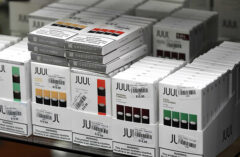Last Updated on February 9, 2016 by
Subject: Big Tobacco
If there’s one thing you can count on with a nascent industry with a similarity to an older, more entrenched one, it’s that the big movers and shakers of the preceding industry are going to do one of two things: beat ’em or join ’em.
So we should feel a sense of relief, I guess, that Philip Morris/Altria, RJ Reynolds, and Lorillard, three of the biggest names in the tobacco industry, have elected to “join ’em” when it comes to vaping. But how much should relief be tempered with vigilance, and how much skepticism regarding their products is healthy?
To arrive at what I think is a sound answer — your mileage may and no doubt will vary, of course — it’s useful to take a look at the past behavior of companies like Altria, RJ Reynolds and Lorillard with regard to user safety and product disclosure.
First, let’s take a look at what’s in a cigarette. Funny thing: I used to think it was tobacco. But according to the American Journal of Public Health, this stuff is about as far from being actual tobacco as a Big Mac is from being a Porterhouse steak.
Big Tobacco uses a material called “sheet” in cigarettes. What is “sheet”? According to the American Journal of Public Health, sheet is, “recycled stems, stalks, scraps, collected dust, and floor sweepings. Those materials are ground up, nicotine is extracted from them, and chemicals, fillers, glue, and other agents are added to the slurry. The sheet is then pressed out and puffed, with the previously extracted nicotine sprayed onto it, and ground into tiny curls before being incorporated into cigarettes at the desired level.” (http://www.ncbi.nlm.nih.gov/pmc/articles/PMC2040350/)
So now let’s look back at one of the phrases that’s used there: “other agents.” What kind of “other agents“? Well, we have a pretty good source of information already with the American Journal of Public Health, so let me quote a little more:
In addition, tobacco companies have devoted a significant amount of research and development to the use and inclusion of additives in cigarettes, and the industry has acknowledged using 599 different cigarette additives. According to various tobacco company documents, many of these additives are used to improve taste and decrease harshness. We propose that, in contrast, tobacco companies have expended resources to exploit the pharmacological and chemical effects of cigarette additives.
The tobacco industry used few additives in US cigarettes before 1970. However, current US-style cigarettes generally contain about a 10% level of additives according to weight, mostly in the form of sugars, humectants, ammonia compounds, cocoa, and licorice. Most other additives are used in small amounts, less than 0.01% of total weight. There is evidence that the percentage of additives by weight may have increased in the 1990s, especially the use of sweeteners (which many researchers believe were added to entice younger people to smoke). Those increases roughly coincided with the controversial Joe Camel cigarette advertising campaign initiated by RJ Reynolds in 1985.
Previous studies have reviewed the use of ammonia technology to increase levels of nicotine and free base nicotine in cigarette smoke18; the use of additives with additional or synergistic addictive potential, anesthetic properties, or bronchodilator effects; and the use of additives that decrease environmental tobacco smoke (ETS) odor, visibility, and irritation without equivalent efforts to decrease the harmful effects of ETS. These tobacco industry practices, motivated by awareness of public concern regarding ETS, may have led to nonsmokers as well as smokers being unaware or less aware of the presence of hazardous substances associated with ETS.
In this study, we examined the tobacco industry’s use of additives that inhibit nicotine metabolism and increase the addictive potential of cigarettes, with a particular focus on the neurological techniques used by Philip Morris to assess the effects of additives on smokers’ central nervous system functioning. We also explored the addition of antioxidants and mitigants to cigarettes in an attempt to prevent illness, genetic modifications of tobacco to increase levels of beta-carotene and incorporate molecules intended to decrease carcinogenic tobacco-specific nitrosamines, the use of other “beneficial” additives and specific chemical additives, and the tobacco industry’s objections to scientific discussions about additives used for cigarette engineering and nicotine addiction.
So what we are essentially dealing with, when it comes to Big Tobacco, is an industry which has expended a whole lot of time, money and scientific expertise in devising a product that is as addictive as it possibly can be, with no regard to the safety of its products’ users.
Given that, we absolutely must exercise skepticism and wariness when it comes to these same companies entering into the vaping industry. We have no choice; these companies have already demonstrated that user safety is not among their priorities.
What is the future of vaping with Big Tobacco entering the scene? Well, the fact is that we can only speculate. But let me offer two distinctly different predictive scenarios:
First: Big Tobacco continues on with the same tactics it has used in the past. In this scenario, Big Tobacco offers its own “vision” of vaping, in which it plays the “good corporate citizen” by offering products in only 9mg and 12mg nicotine strengths, in only tobacco or menthol flavors (in accordance with flavor restrictions in the Tobacco Control Act)… and then lobbies for all PV and eliquid manufacturers to be restricted by regulation to those same flavors and strengths, eliminating the competitive advantage of most independent eliquid manufacturers, as well as pressing for regulations banning online sales (“for the children”, naturally), leaving it a, if not the, big game in retail town.
In the second possible scenario, Big Tobacco accepts the transition from smoking to vaping as the dominant delivery system for recreational nicotine in the 21st century. They understand and accept that smoking was the way to get nicotine in the 19th and 20th centuries, but that’s over now, and vaping is now how it’s done.
They apply their deep pockets, powerful legal teams, and lobbyist dollars to ensuring freedom for vapers of adult age, supporting only smart regulation, such as prohibition on underage vaping, transparency in eliquid contents, and quality assurance.
While I think that many of us will be understandably and logically wary of Big Tobacco taking the former path rather than the latter, we are not helpless. We, as vapers, are not without a voice. We have it within our power to reject Big Tobacco’s entry into the vaping industry, and to resist it, if they do go sideways on us again.
There are a few things for each of you, personally, to understand here.
First: You have already quit smoking. (Well, unless you haven’t, but I think my odds are pretty good when I say that if you’ve found Spinfuel, you probably already have.) Because you’ve already quit smoking, you are already free. Even if Big Tobacco does go full tilt evil on us, and even if they do succeed in restricting vaping to their tiny little window of competence, we have already beaten them. We have already won the war. At this point, they’re just snapping that bear trap of theirs on empty air.
Second, we have avenues of resistance. CASAA is one of them. Media outlets like Spinfuel are another. Your wallet is yet another. With millions of people leaving smoking in favor of vaping, what millions of people are discovering is that vaping is the genuinely effective way to finally leave nicotine behind — pain free, and for good. And even if Big Tobacco rigs the game so that they’re the only player on the board, that’s still going to happen, because of this:
Vaping is similar enough to smoking to substitute for it, but different enough from smoking that quitting it isn’t nearly as difficult. So let’s all keep an eye on Big Tobacco. And let’s hope for the best, but let’s also not fear the worst.
To bastardize a line from Hollywood: This is John Castle. And if you’re reading this, you are the Resistance.








